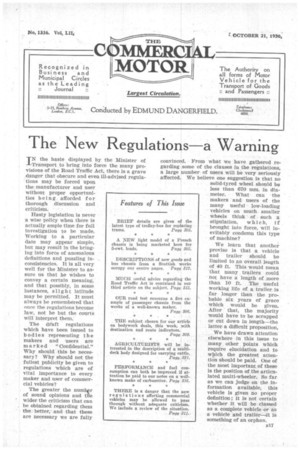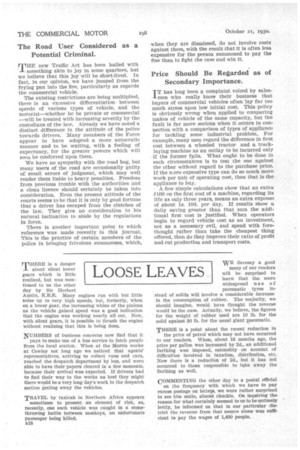The New Regulations a Warning
Page 43

Page 44

If you've noticed an error in this article please click here to report it so we can fix it.
TN the haste displayed by the Minister of -I-Transport to bring into force the many provisions of the Road Traffic Act, there is a grave danger that obscure and even ill-advised regulations may be forced upon the manufacturer and user without proper opportuni ties being afforded for thorough discussion and criticism.
Hasty legislation is never a wise policy when there is actually ample time for full investigation to be made. Working to a particular date may appear simple, but may result In the bringing into force of anomalous definitions and puzzling inconsistencies. It is all very well for the Minister to assure us that he wishes to convey a certain meaning, and that possibly, in some instances, slight latitude may be permitted. It must always be remembered that once the regulations become law, not he but the courts will interpret them.
The draft regulations which have been issued to bodies representing the makers and users are marked "Confidential." Why should this be necessary? Why should not the fullest publicity be given to regulations which are of vital importance to every maker and user of commercial vehicles?
The greater the numbv of sound opinions and the wider the criticism that can be obtained regarding them the better, and that these are necessary we are fully convinced. From what we have gathered regarding some of the clauses in the regulations, a large number, of users will be very seriously affected. We believe one suggestion is that no solid-tyred wheel should be less than 670 mm. in dia meter. What can the makers and users of the many useful low-loading vehicles on much. smaller wheels think of such a stipulation, which, if brought into force, will inevitably condemn this type of machine?
We learn that another proviso is that a vehicle and trailer should be limited to an overall length of 40 ft. This would mean that many trailers could not have a length of more than 10 ft. The useful working life of a trailer is far longer than the probable six years of grace which would be given. After that, the majority would have to be scrapped or cut down in length—the latter a difficult proposition.
We have drawn attention elsewhere in this issue to many other points which require elucidation and to which the greatest attention should be paid. One of the most important of these is the position of the articulated multi-wheeler. So far as we can judge on the information available, this vehicle is given no proper definition; it is not certain whether it will be classed as a complete vehicle or as a vehicle and trailer—it is something of an orphan.
The Road User Considered as a Potential Criminal.
:THE new Traffic Act has been hailed with -Isomething akin to joy in some quarters, but we believe that this joy will be short-lived. In fact, in our opinion, we have jumped from the frying pan into the lire, particularly as regards the commercial vehicle.
The existing restrictions are being multiplied, there is an excessive differentiation between speeds of various types of vehicle, and the motorist—whether he be private or commercial —will be treated with increasing severity by the custodians of the law. Already we have noted a distinct difference in the attitude ef the police towards drivers. Many members of the Force appear to have adopted a more autocratic manner and to be waiting, with a feeling of expectancy, for tile greater powers which will soon be conferred upon them.
We have no sympathy with the road hog, but many users of the road are occasionally guilty of small errors of judgment, which may well render them liable to heavy penalties. Freedom from previous trouble with the authorities and a clean licence should certainly be taken into consideration. Even the present attitude of the courts seems to be that it is only by good fortune that a driver has escaped from the clutches of the law. They give no consideration to his natural inclination to abide by the regulations in force.
There is another important point to which reference was made recently in this journal. This is the practice of certain members of the police in bringing frivolous summonses, which, when they are dismissed, do not involve costs against them, with the result that it is often less expensive for the person summoned to pay the fine than to fight the case and win it.
Price Should Be Regarded as of Secondary Importance.
TT has long been complaint voiced by sales-I-men who really know their business that buyers of commercial vehicles often lay far too much stress upon low initial cost. This -policy is obviously wrong when applied to comparing makes of vehicle of the same capacity, but the fault is far more serious when it occurs in connection with a comparison of types of appliance for tackling some industrial problem. For example, many men regard the difference in first cost between a wheeled tractor and a track. laying machine as an outlay to be incurred only if the former fails. What ought to be done in such circumstances is to test the one against the other without regard to the purchase price. If the more expensive type can do so much more work per unit of operating cost, then that is the appliance to buy.
A few simple calculations show that an extra f.100 on the first cost of a machine, regarding its life as only three years, means an extra expense of about is. 10d. per day. If results show a daily saving greater than that sum the additional first cost is justified. When operators begin to regard vehicle cost as an investment, not as a necessary evil, and spend with forethought rather than take the cheapest thing offered, then do they improve their ratio of profit and cut production and transport costs.




















































































































